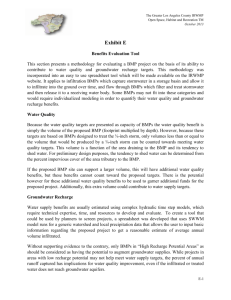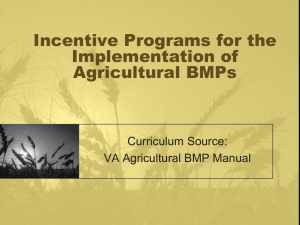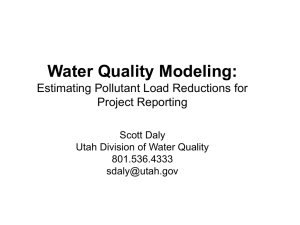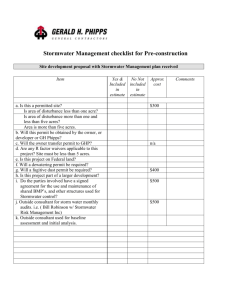19. Appendix H_Appendix F Benefit Evaluation Tool
advertisement
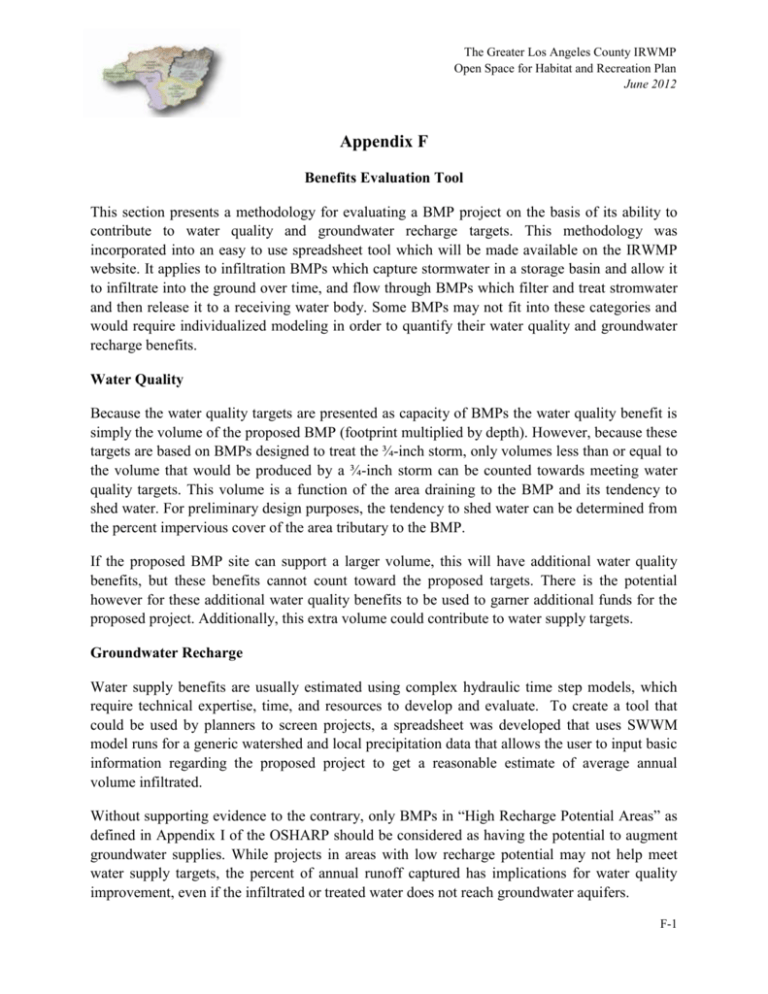
The Greater Los Angeles County IRWMP Open Space for Habitat and Recreation Plan June 2012 Appendix F Benefits Evaluation Tool This section presents a methodology for evaluating a BMP project on the basis of its ability to contribute to water quality and groundwater recharge targets. This methodology was incorporated into an easy to use spreadsheet tool which will be made available on the IRWMP website. It applies to infiltration BMPs which capture stormwater in a storage basin and allow it to infiltrate into the ground over time, and flow through BMPs which filter and treat stromwater and then release it to a receiving water body. Some BMPs may not fit into these categories and would require individualized modeling in order to quantify their water quality and groundwater recharge benefits. Water Quality Because the water quality targets are presented as capacity of BMPs the water quality benefit is simply the volume of the proposed BMP (footprint multiplied by depth). However, because these targets are based on BMPs designed to treat the ¾-inch storm, only volumes less than or equal to the volume that would be produced by a ¾-inch storm can be counted towards meeting water quality targets. This volume is a function of the area draining to the BMP and its tendency to shed water. For preliminary design purposes, the tendency to shed water can be determined from the percent impervious cover of the area tributary to the BMP. If the proposed BMP site can support a larger volume, this will have additional water quality benefits, but these benefits cannot count toward the proposed targets. There is the potential however for these additional water quality benefits to be used to garner additional funds for the proposed project. Additionally, this extra volume could contribute to water supply targets. Groundwater Recharge Water supply benefits are usually estimated using complex hydraulic time step models, which require technical expertise, time, and resources to develop and evaluate. To create a tool that could be used by planners to screen projects, a spreadsheet was developed that uses SWWM model runs for a generic watershed and local precipitation data that allows the user to input basic information regarding the proposed project to get a reasonable estimate of average annual volume infiltrated. Without supporting evidence to the contrary, only BMPs in “High Recharge Potential Areas” as defined in Appendix I of the OSHARP should be considered as having the potential to augment groundwater supplies. While projects in areas with low recharge potential may not help meet water supply targets, the percent of annual runoff captured has implications for water quality improvement, even if the infiltrated or treated water does not reach groundwater aquifers. F-1 The Greater Los Angeles County IRWMP Open Space for Habitat and Recreation Plan June 2012 Evaluation Tool Technical Background Stormwater BMPs can be conceptualized as having a storage volume and a treatment rate, in various proportions. Both are important in the long-term performance of the BMP under a range of actual storm patterns, depths, and inter-event times. Long-term performance is measured by the operation of a BMP over the course of multiple years, and provides a more complete metric than the performance of a BMP during a single event, which does not take into account antecedent conditions, including multiple storms arriving in short timeframes. A BMP that draws down (infiltrates) more quickly would be expected to capture a greater fraction of overall runoff (i.e. long-term runoff) than an identically sized BMP that draws down more slowly. This is because storage is made available more quickly, so subsequent storms are more likely to be captured by the BMP. In contrast a BMP with a longer drawdown time (infiltrates slowly) would stay mostly full, after initial filling, throughout periods of sequential storms. The volume in the BMP that draws down more quickly is more “valuable” in terms of long term performance than the volume in the one that draws down more slowly. An evaluation of the relationships between BMP design parameters and expected long term capture efficiency has been conducted to assist in planning and assessment of various alternative projects. Relationships have been developed through a simplified continuous simulation analysis of precipitation, runoff, and routing, that relate BMP design volume and storage recovery rate (i.e., drawdown time) to an estimated long term level of performance. Modeling Methodology The USEPA Stormwater Management Model Version 5.0 (SWMM5.0) was used to simulate the long term average capture efficiency for a range of general BMP design configurations over several decades. SWMM was selected for this analysis as it is a relatively simple, open source, continuous simulation model that has well-demonstrated capability for simulation of rainfallrunoff processes in urban environments and simulating transient storage mechanisms in BMPs. A relatively simple representation of BMPs was used to develop the general relationships that conceptualized all BMPs as having a storage volume and a treatment or drawdown rate. While this representation does not account for the nuances of BMP designs, it is appropriate for planning level assessment. Assumed SWMM input parameters are provided in Error! Reference source not found.. Sensitivity analyses demonstrated that the only inputs with significant sensitivity within typical input ranges were the precipitation and ET inputs and the BMP configurations. These were selected to be representative of several locations in Los Angeles County. Results are interpreted to allow scaling across the various rainfall regimes of the County. F-2 The Greater Los Angeles County IRWMP Open Space for Habitat and Recreation Plan June 2012 SWMM Parameters Units Period of Simulation years Wet time step Wet/dry time step Dry time step seconds seconds seconds Precipitation inches Impervious Manning’s n Hypothetical drainage area acres Shape Impervious fraction modeled Slope ft/ft Evaporation inches Depression storage, inches impervious Runoff coefficient used to convert precipitation depth to unitless design volume Design capture storm depth (85th percentile, 24-hour inches depth) calculated from Irvine Gage BMP Storage Volume cu-ft Values 10/01/1948 to 10/01/2008 (except Lechuza Patrol Station, through 1997) 900 900 14,400 Hourly precipitation data from: COOP 045114 – Los Angeles Airport COOP 044867 – Lechuza Patrol Station COOP 047762 – San Fernando 3 COOP 041194 – Burbank Airport See Table 2 for statistics 0.012 50 (not significantly sensitive to results) Rectangular, 500 ft flow path length; representing typical overland flow to reach a channelized or piped conveyance (not significantly sensitive parameter). 100% 0.05 Monthly Normal ET from CIMIS ET Zones Map × 60% Crop Coefficient LAX and Lechuza: Zone 4 Burbank Airport: Zone 6 San Fernando 3: Zone 9 See Table 3 for monthly normal ETo 0.05, based on Table 5-14 in SWMM manual (James and James, 2000) 0.95 (approximately consistent with modeled runoff in SWMM) Varied over continuous range from 0.025 to 5 inches Calculated based on design storm and tributary area. V = depth × runoff coeff × area × conversion factors Example: V (cu-ft) = 1.0 inches × 0.95 × 50 ac × 43,560 sq-ft × (1 ft/12 inches) = 172,400 cu-ft F-3 The Greater Los Angeles County IRWMP Open Space for Habitat and Recreation Plan June 2012 SWMM Parameters Units Drawdown Time hours BMP Discharge cfs Period of Simulation years Wet time step Wet/dry time step Dry time step seconds seconds seconds Precipitation inches Impervious Manning’s n Hypothetical drainage area acres Shape Impervious fraction modeled Slope ft/ft Evaporation inches Depression storage, inches impervious Runoff coefficient used to convert precipitation depth to unitless design volume Design capture storm depth inches F-4 Values Varied over continuous range from 0.1 hour to 2,400 hours Calculated based on design volume and drawdown time. Q (cfs) = V(cu-ft) / Drawdown time (s) Example: 172,400 cu-ft / (48 hr × 3600 s/hr) = 0.997 cfs 10/01/1948 to 10/01/2008 (except Lechuza Patrol Station, through 1997) 900 900 14,400 Hourly precipitation data from: COOP 045114 – Los Angeles Airport COOP 044867 – Lechuza Patrol Station COOP 047762 – San Fernando 3 COOP 041194 – Burbank Airport See Table 2 for statistics 0.012 50 (not significantly sensitive to results) Rectangular, 500 ft flow path length; representing typical overland flow to reach a channelized or piped conveyance (not significantly sensitive parameter). 100% 0.05 Monthly Normal ET from CIMIS ET Zones Map × 60% Crop Coefficient LAX and Lechuza: Zone 4 Burbank Airport: Zone 6 San Fernando 3: Zone 9 See Table 3 for monthly normal ETo 0.05, based on Table 5-14 in SWMM manual (James and James, 2000) 0.95 (approximately consistent with modeled runoff in SWMM) Varied over continuous range from 0.025 to 5 inches The Greater Los Angeles County IRWMP Open Space for Habitat and Recreation Plan June 2012 SWMM Parameters (85th percentile, 24-hour depth) calculated from Irvine Gage Units BMP Storage Volume cu-ft Drawdown Time hours BMP Discharge cfs Values Calculated based on design storm and tributary area. V = depth × runoff coeff × area × conversion factors Example: V (cu-ft) = 1.0 inches × 0.95 × 50 ac × 43,560 sq-ft × (1 ft/12 inches) = 172,400 cu-ft Varied over continuous range from 0.1 hour to 2,400 hours Calculated based on design volume and drawdown time. Q (cfs) = V(cu-ft) / Drawdown time (s) Example: 172,400 cu-ft / (48 hr × 3600 s/hr) = 0.997 cfs Rainfall Statistics, Modeled Gages Station ID 41194 44867 45114 47762 Name BURBANK WB AP LECHUZA PTRL ST FC352B LOS ANGELES WSO AP SAN FERNAND O PH 3 Data Tempor al Resolut ion Data Depth Resolution (in.) Modeled POR Missing & Accumu lated Fraction of Record (not simulate d) Hourly 0.01 WY 19492008 6% 13.67 1.35 Hourly 0.01 WY 19491997 5% 19.17 1.70 Hourly 0.01 WY 19492008 1% 12.16 1.02 Hourly 0.01 WY 19492008 8% 16.70 1.43 Calculat ed Avg. Annual Rainfall (in.) Calcul ated 85th, 24-hr (Event s> 0.1", MIT 6 hrs) F-5 The Greater Los Angeles County IRWMP Open Space for Habitat and Recreation Plan June 2012 Monthly Normal ETo Reference ET CIMIS ET Zone Zone 4 Zone 6 Zone 9 F-6 Oct Nov Dec Annual Normal 3.41 4.50 5.27 5.7 5.89 5.58 4.50 3.41 2.40 1.86 46.6 2.24 3.41 4.80 5.58 6.3 6.51 4.80 3.72 2.40 1.86 49.7 2.80 4.03 5.10 5.89 6.6 7.44 6.82 5.70 4.03 2.70 1.86 55.1 Jan Feb Mar 1.86 2.24 1.86 2.17 Apr May Jun Jul Aug 6.2 Sep
